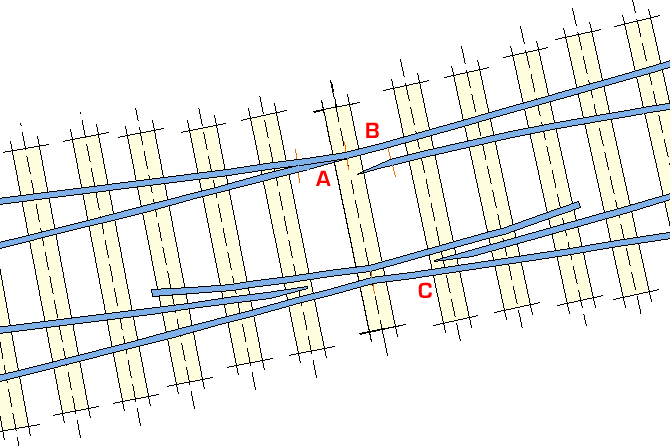Templot Club Archive 2007-2020
|
|||
| author | remove search highlighting | ||
|---|---|---|---|
|
posted: 11 Apr 2015 22:18 from: Ian Allen
click the date to link to this post click member name to view archived images |
Gents, Does anyone know if the single slip in the attached pdf is prototypical at all ? Ian |
||
| Attachment: attach_2110_2670_single_slip.pdf 296 | |||
|
posted: 12 Apr 2015 07:50 from: Jim Guthrie
click the date to link to this post click member name to view archived images |
I think you have lost the checking on the existing "K" crossing to prevent a vehicle going wrong road. The half switched diamond provides no checking for the "K" crossing. Jim. |
||
|
posted: 12 Apr 2015 13:38 from: Ian Allen
click the date to link to this post click member name to view archived images |
Jim, The check rail for the other K crossing is there. Ian |
||
|
posted: 12 Apr 2015 14:40 from: Martin Wynne
click the date to link to this post click member name to view archived images |
Ian Allen wrote:The check rail for the other K crossing is there.Hi Ian, Jim is right, check rails control the crossings in the opposite rail. You don't have any check rail for the fixed K-crossing: 2_120929_320000000.png  Because there is no check rail at A, a wheel-set moving left to right at B can move sideways, such that the opposite wheel flange may hit the nose of the point rail at C, or even go the wrong side of it. The open switch blade at B can't provide any checking because the switch opening is always significantly greater than the check rail gap -- if wheels hit an open switch bade it can damage the stretcher bars and detection gear. So this is definitely not a prototypical arrangement. The puzzling thing is why you would want this? Why not build a normal switch-diamond? You would need to provide the point motors or rodding for one side anyway, so it is easier to do both sides than a fixed K-crossing. The presence of the slip road has no bearing on the matter -- except in so far as the absence of check rails in switch-diamonds makes slips much easier to build where you have overscale model flangeways. regards, Martin. |
||
|
posted: 12 Apr 2015 23:11 from: Ian Allen
click the date to link to this post click member name to view archived images |
Martin & Jim, Apologies, I mis-read the original response. I raised the question because we have had an issue with stock going the wrong side of the fixed crossing rails, where I have substituted switched blades in the pdf, in both directions due to track curvature. I have proved that it works with one blade on the most problematic route, with a 2-6-2T at full speed. However, if there is NO prototype for this, then I'll just have to go the whole hog and replace the other fixed K crossing with switched blades too. Thanks for the input. Ian |
||
|
posted: 12 Apr 2015 23:21 from: Martin Wynne
click the date to link to this post click member name to view archived images |
Hi Ian, Which gauge and standard are you using? What is the crossing angle? One idea you could borrow from the prototype is to raise the check rails above the level of the running rails. This increases the length of contact with the back of the wheel. There are some drawbacks: • you can't run anything with flangeless drivers • it's a great nuisance when track cleaning regards, Martin. |
||
|
posted: 14 Apr 2015 02:50 from: Ian Allen
click the date to link to this post click member name to view archived images |
Hi Martin, O-MF gauge. Irregular curved diamond crossing. Crosssing vee's are 1:7.56 and 1:6.7. I've always thought that check rails should be raised, but I couldn't bring myself to do it on all the ones I've had to make for the SR7mm Group project. Ian |
||
| Please read this important note about copyright: Unless stated otherwise, all the files submitted to this web site are copyright and the property of the respective contributor. You are welcome to use them for your own personal non-commercial purposes, and in your messages on this web site. If you want to publish any of this material elsewhere or use it commercially, you must first obtain the owner's permission to do so. |